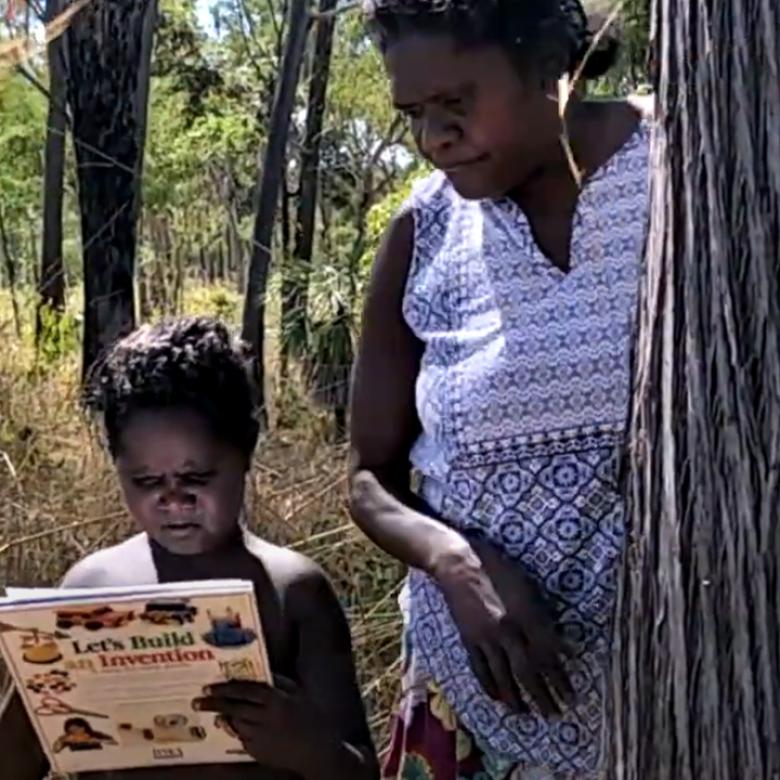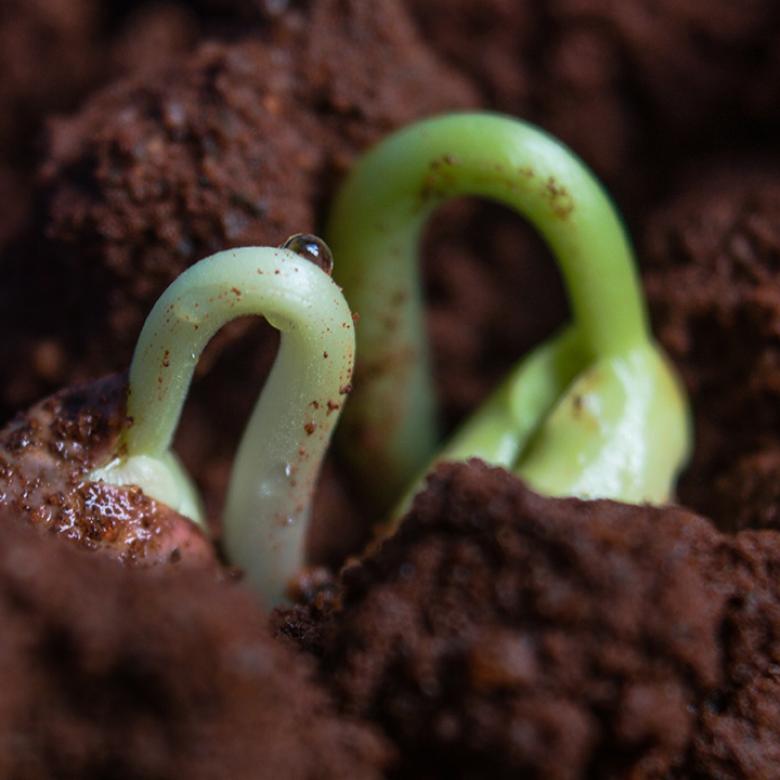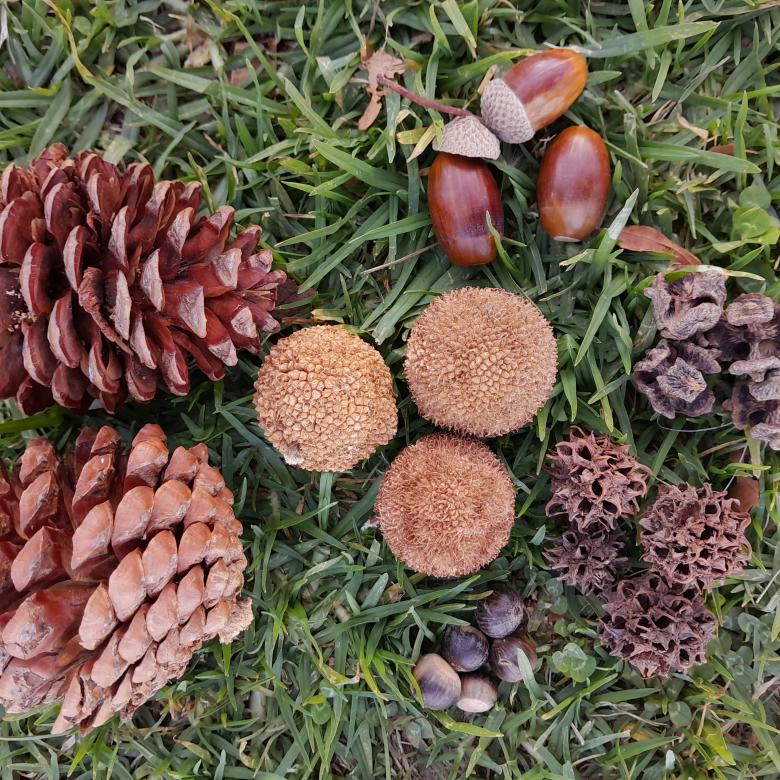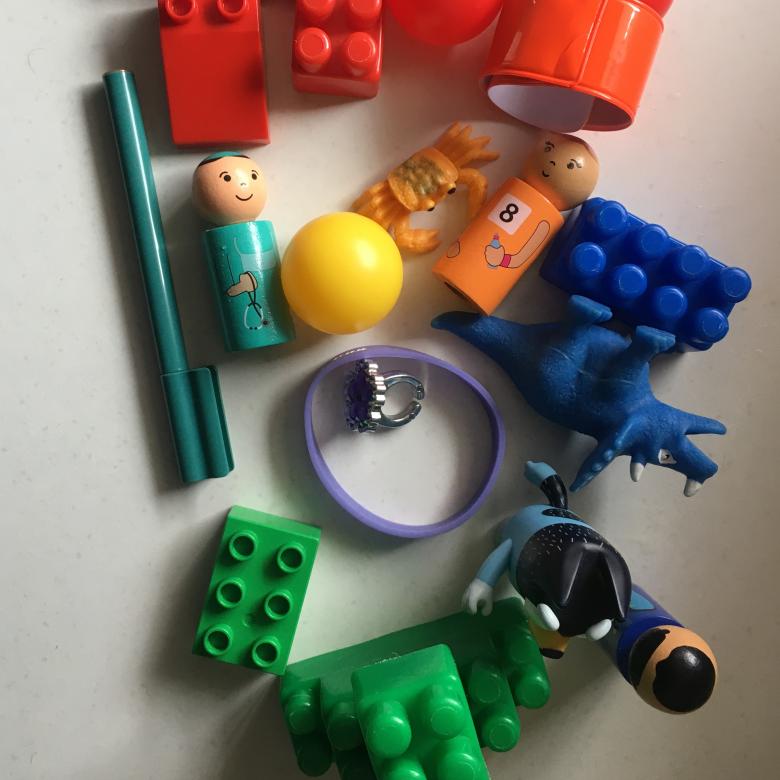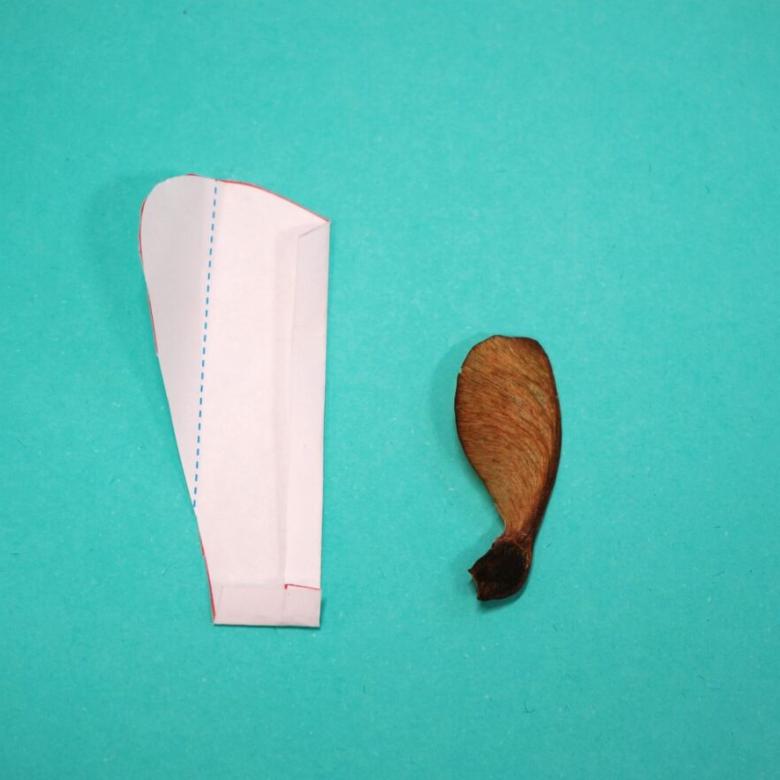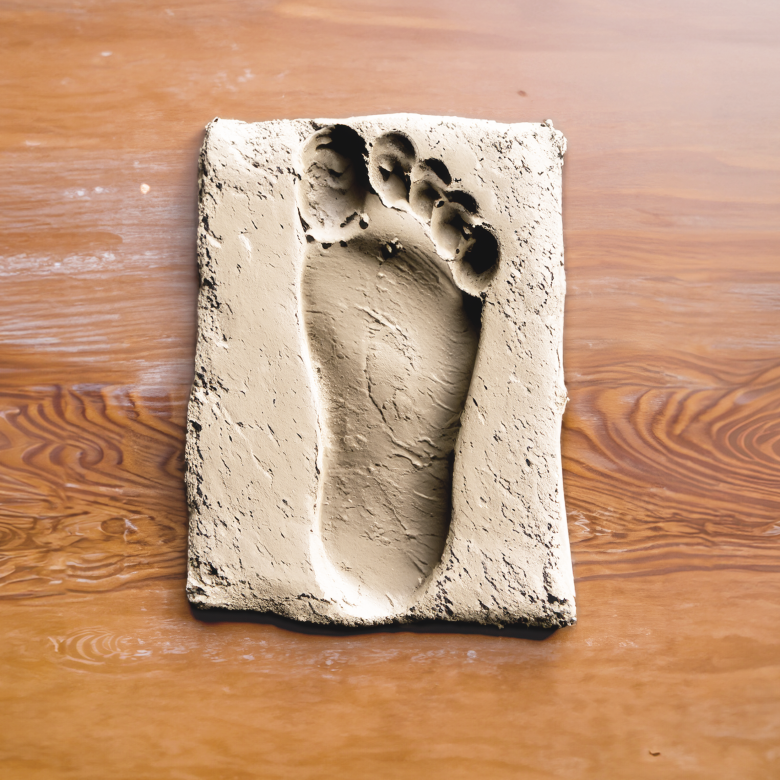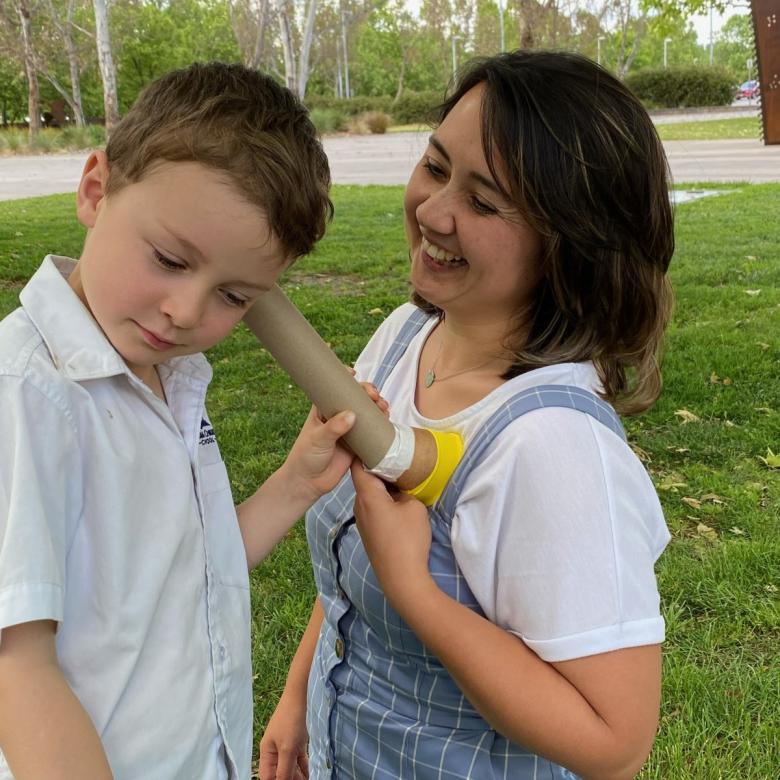You’ll need
- An adult
- Warm weather (sunny days in spring and summer are great)
- A local lake, wetland, garden or park
- A keen eye!
What to do
- Go to your local park, garden or lake and look for frogs and reptiles such as lizards and turtles.
- Listen carefully for noises such as frogs croaking and lizards rustling in the leaves. If you hear these, an animal is close by!
- Look around water for frogs and turtles.
- Look for lizards in warm, sunny spots, such as on a big rock or on a cement footpath.
- Animals will often hide when they hear you, so remember to be quiet and look carefully.
Questions to ask
What kinds of frogs and reptiles did you hear?
What kinds did you see?
What were they doing? Were they swimming, or lying in the sun, or eating?
What's happening
Reptiles cannot warm themselves up like humans can, so they slow right down during the cold months to save energy. When the weather warms up, they come out and warm themselves up in the sun. Because of this, they are easier to spot in spring and summer when they are often on rocks and roads enjoying the sun.
Did you know
Crocodiles, snakes, lizards and turtles belong to the reptile family. The world’s largest reptile is the Australian saltwater crocodile, which can grow to more than 3 m long.
Frogs are amphibians, not reptiles. Baby frogs are called tadpoles and live in water. They have gills to help them breathe under water, and tails to help them swim. They don’t look like frogs until they grow up. As they grow, they change the shape of their bodies and lose their tail, grow legs and lungs, and change into a frog! This process is called metamorphosis.
Dion: Hi boys and girls, and welcome to Science Time at Questacon. I’m Dion.
BJ: And I’m BJ.
Dion: And today we’re talking about reptiles and frogs.
BJ: Fantastic.
Dion: Let’s go.
BJ: [Giggles]
[Science Time logo]
[Music playing]
[Singing]
Wake up sun and moon, it’s Science Time, it’s Science Time.
Wake up skeleton, it’s Science Time, it’s Science Time.
At home in the bathroom, when we’re swimming there is science,
Outside at the playground, in the sunshine, there is science.
Wake up.
[Science Time logo – Title, “Reptiles and Frogs”]
Dion: So, hello everyone, welcome, welcome to Science Time. Hands up who thinks they know what we’re talking about today.
[Children raise their hands excitedly]
Child: Me!
Dion: What do you think we’re talking? And shout it out, what do you think?
Child: Reptiles and frogs.
Dion: What are we talking about today?
[Dion holds his hand to his ear]
Children: Reptiles.
Dion: Reptiles and frogs.
BJ: Reptiles and frogs.
Dion: Lots of reptiles and lots of frogs. Now can anyone tell me, what is a type of reptile? Can anyone tell me a type of reptile? What do you think? [Dion points to a child]
Child: Snake.
Dion: A snake. Fantastic.
BJ: Ooh, snakes. Absolutely.
Dion: So BJ’s going to look for a picture of a snake. I’ll hold that up. There we are.
[Dion holds up a picture of a snake]
BJ: Here’s a picture.
Dion: So, this one is a snake. Isn’t that cool? What colour is the snake?
Child: Orange.
Child: Orange and black.
Dion: Orange and black. Lots of different colours, isn’t it? [Close up picture of the snake]
Child: And white.
Dion: And white as well. So this is a snake here. What sound does a snake make?
[Children collectively make a hissing sound]
Dion: Very good, nice work.
BJ: [Laughs]
Dion: Now we’ll put the snake down there. Now, does anyone know any other types of reptiles? What do you think?
Child: Crocodiles.
Dion: Crocodile. Very good choice.
BJ: Oh-ho!
Dion: There we are, we’ve got our crocodile right here.
[Dion holds up a picture of a crocodile]
Child: I can’t see it.
Dion: Now, are our crocodile’s teeth big or small?
Children: Big.
Dion: They’re pretty big, aren’t they? Crocodiles have got big teeth.
[Close up picture of a crocodile]
Dion: So there’s our crocodile. Now, crocodiles, they’ve got a very pointy mouth – you might have said alligator at home – alligator is a little bit different. So crocodiles have a pointy mouth, alligators have got a U shaped mouth, sort of like that.
[BJ holds up a picture of an alligator]
Dion: There we are. So crocodiles and alligators, quite a lot the same, but a little bit different as well. Now, does anyone know another type of reptile? What do you think?
Child: Um...
Dion: Sitting on your bottom for me. Can you think of any other reptile? We might come back to you. What do you think – what’s another reptile?
Child: A lizard.
Dion: A lizard. Fantastic. There’s our lizard right here.
[Dion holds up a picture of a lizard]
Dion: Hands up who’s seen a lizard before?
[Children raise their hands]
Child: I seen one out the front.
Dion: You might have seen one out the front.
BJ: Wow.
Dion: If you’re very lucky you could see one in your backyard, maybe at the zoo, or maybe, yeah, at someone else’s house maybe. So we’ve got our lizard right here. We’ll be talking about lizards quite a lot today, so there’s our lizard.
Now, our next one, this is a bit of a harder one, do you think you know another reptile? What do you think it might be?
Child: I know one that’s old, but it’s not a reptile.
Dion: Oh, OK, well we’ll talk about that one a little bit later maybe. This reptile I’m thinking of has a shell – a shell.
Children: A turtle.
Dion: A turtle. Well done. So there’s our turtle right here.
[Dion holds up a picture of a turtle to show the children].
Dion: Now, this turtle, where is it living at the moment?
Child: Under water.
Dion: It’s under water isn’t it? Sitting on your bottom for me. So it’s living under water, so you can see its got flippers here, really flat sort of arms, and that helps it swim really well.
Child: And it has webbed feet.
Dion: It might have webbed feet as well.
Child: And it can go (indistinct words – 3:07) so it doesn’t eat.
Dion: So if it’s a bit scared sometimes it can go inside of its shell as well, which we’ll talk about very soon. Now this one, it looks a bit like a turtle, but what do you think this one’s called?
[Dion holds up a picture of another reptile to show the children]
Children: It’s a tortoise.
Dion: Well done, it’s a tortoise. So what happens? Where does this animal live? Where does a tortoise live?
Child: In a shell.
Child: On land.
Child: On land.
[Science Time logo]
Dion: Does anyone know, what is this animal?
[Dion holds up a snake]
Children: Snake.
Dion: A snake. What sound does a snake make again?
[Children make hissing noises]
Dion: A snake makes an ‘sss-ing’ sound, there we are. So we’ll put our snake right there.
[Dion places the snake on the ground in front of the children]
Dion: The next animal we’ll look at, we might have a look at this one, what animal is this?
Children: Lizard.
Dion: A lizard. Can everyone stick out your tongue like a lizard?
[Everyone pokes out their tongue]
Dion: Now, we’ve got something called a blue tongue lizard here in Australia. Is our tongue blue?
Children: No.
Dion: No, it’s not blue, is it? It’s not really blue like a lizard.
Child: Sometimes when we eat blue cake our tongue gets blue.
Dion: Sometimes if you eat blue cake you might.
Child: It’s pinky – its pinky red.
Dion: It’s a bit pink red, isn’t it? Now our next one...
Child: Crocodile.
Dion: What’s this?
Children: Crocodile.
Dion: Crocodile. A crocodile – now a crocodile has got big teeth, you can see there, and I want everyone to show me your big teeth. Can everyone show me your big teeth – snap, snap, snap.
[Everyone stretching out their arms and making shape of crocodile mouth snapping]
Dion: Can you be a crocodile? Snap, snap, snap, snap, snap. Good work. And the last one we’re going to talk about is this one here – what’s this one called?
[Dion holds up a turtle]
Children: Turtle.
Dion: A turtle – it’s a turtle, isn’t it?
Child: It’s very soft.
Dion: And it’s got flippers, and it is very soft isn’t it? Now this one has got a shell which protects itself, so I want everyone to try and pretend to be a turtle inside its shell. Can everyone hide inside your shell?
BJ: Can you go into your shell?
[Everyone scrunches up small and pretends to hide in their shell like a turtle]
Dion: Hide inside your shell. Everyone peek out, peek out of your shell, and back in, back in your shell.
[Everyone peeks out and then hides again]
Dion: Good work. Well done everyone. So we’ve got all of these different reptiles here. Now do these reptiles look the same or different?
Children: Different.
Dion: They look different, don’t they? But all of these reptiles have got something that’s the same, and that’s why they’re all reptiles.
[Close up camera shot of the various reptiles]
Dion: So for instance, all of these reptiles have got very similar skin. What type of skin do you think a reptile might have? Scaly skin? It’s got scaly skin. Now if everyone feels your fingernail – feel your fingernail for me – is your fingernail hard or soft?
[Everyone feels their fingernail]
Child: Hard.
Child: Hard.
Dion: It’s pretty hard, isn’t it, and it protects our fingers. Now, all of the skin on a reptile is made out of this hard keratin stuff, it’s called keratin, it’s this hard fingernail stuff, and it’s like they’ve got fingernails all over their body, which keeps them really nice and protected, and really, really safe with their skin.
[Science Time logo]
Dion: So here we have some skin from another animal, what skin do you think this, what animal do you think this came from?
[Dion is holding up a snakeskin]
Child: Snake.
Child: Crocodile.
Dion: From a snake, this is some snake skin. Now if everyone wants to take a piece of some snake skin, you can take a piece and feel what it feels like.
[Children taking a piece of snakeskin]
Child: But how did you take a piece of snake skin…?
Dion: Well what happens is a snake loses its skin when it gets bigger, so when a snake grows to be a big snake, like when we get new clothes and that sort of stuff, a snake will get new skin instead. There we are. So you can have a feel. Once you’ve finished though, put it back into the box for me. Everyone help, and put it back in the box.
BJ: What does it feel like?
Child: It feels tickly.
Dion: It feels ticklish does it?
BJ: Does it? And is it soft?
Child: It’s warm.
BJ: Warm, is it?
Child: I feeled skin at the reptile park.
BJ: Oh, wow.
Dion: So it’s a bit soft, and it’s a bit crunchy. There we are, a bit like paper. There we are.
[Science Time logo]
Dion: Now, that skin helps keep them nice and safe, but there’s another thing that all of these reptiles have – does anyone else know what all reptiles have the same, any other ideas? Well for instance when you...
Child: Um, they all have the scaly skin.
Dion: They all do have scaly skin, but for instance when you’re cold, how do you keep warm?
Child: Er...
Dion: What do you do?
Child: We put a jacket on.
Dion: You put a jumper or a jacket on, don’t you? Have you ever seen a lizard with a jumper on?
Child: No.
Child: Yeah, I’ve...
Child: But, but...
Child: No? It’s a bit funny if a lizard’s wearing a jumper.
Child: But reptiles go in warm places to get warm.
Dion: It’s very true. So we put on jumpers to stay warm, but reptiles, they go into warm places to get warm. So what they do...
Child: And there’s another thing, because they have cold blood and we have warm blood.
Dion: That is exactly right. They have cold blood and we have warm blood. So I want everyone – everyone listening, being very, very quiet – can everyone feel your cheeks for me? Feel your cheeks? Now are your cheeks warm or cold?
[Everyone is using their hands to feel their cheeks]
Children: Warm.
Dion: They’re nice and warm, aren’t they? That’s because we’re warm blooded, so we eat lots of food, we burn that energy from the food to keep ourselves nice and warm, we can warm ourselves up with a nice big jacket if we need to.
Child: Yeah.
Dion: Now reptiles, they don’t do that. What they do is they don’t have to eat as much, but instead they go into warm places, like in the sun or on a warm rock to keep themselves nice and warm, because they can’t regulate their own body temperature. They get their heat from an external source. There we are.
So we’ve got lots and lots of reptiles that all have very similar things. Another thing most reptiles have in common is that most reptiles lay eggs – most reptiles lay eggs – and they lay them on the land, which is important. Now baby reptiles look a lot like their mum or dad, so if this was a mum or a dad lizard, a baby reptile would be a lot smaller, but it would look almost exactly the same as its mum or dad, just a bit smaller is all.
[Dion is holding up a lizard to show the children]
Dion: There we are. Look at this! What animal is this?
[Dion holds up a picture of a tree frog]
Child: Tree frog. A tree frog.
Children: A frog.
Child: A frog.
Dion: It’s a frog, isn’t it? It’s a frog.
Child: A tree frog.
BJ: Yes.
Dion: Now, is a frog a reptile?
Child: Yep.
Children: No.
Dion: It’s not? It’s not a reptile. A frog is something called an amphibian. Can everyone say amphibian for me?
Children: Amphibian.
BJ: Amphibian. That’s a tricky word.
Dion: It’s a pretty trick word. Amphibian. Now, a frog has some things that are the same as a reptile, but has some things that are different as well. Now a frog, it’s got different skin, it’s got smooth skin, but it’s not scaly, so it’s got smooth skin. And it also is cold blooded, so if you touch a frog or a reptile they’re going to be cold when we’re going to be warm, because we’re warm blooded.
[Science Time logo]
Dion: Now, these are some frog eggs. Now these frog eggs are laid in the water.
[Dion is holding up a picture of frog eggs for the children to see]
Child: They’re called spawn.
Dion: They are; they might be called spawn. So they’re laid in the water, when reptiles lay their eggs on the land. Yeah? Did you have something to say?
Child: Baby frogs are tadpoles.
Dion: They are. Hands up who’s heard of tadpoles before?
[Children raise their hand]
Dion: You might have heard of a tadpole. There’s a tadpole right there.
[Dion holds up a picture of a tadpole for the children to see]
Dion: Does this look like a mum or dad frog?
Children: No.
Dion: Not really, does it? So what happens is a tadpole first of all starts out very small, so that’s what a tadpole looks like when it’s a little baby? Now it doesn’t look very much like a frog, does it, because that’s what its mum or dad looks like, because that’s what its mum or dad looks like?
[Dion places a frog on the ground in front of the children]
Child: Dion?
Dion: Do they look the same or different?
Child: Dion?
Dion: Very different. Yes?
Child: Can I feel the tadpole?
Dion: We’ll have a feel a little bit later, because we’re going to have a look at it and see what they look like first. Now what happens is the tadpole starts to grow a bit older, and it starts to grow legs.
[Dion places a different tadpole in front of the children]
Dion: So first of all it’ll grow its back legs there, and it’s starting to look a little bit more like a frog.
[Dion points to the tadpole in front of him]
Dion: Then next it’ll grow some front legs – is it starting to look a little bit more like a frog now?
[Dion places a different tadpole in front of the children]
Dion: Then what happens, you can see this froglet – which is what we call them – froglet has a bit of a tail, and it drops its tail.
[Dion points to the tadpole, and then places a froglet in front of the children]
Dion: It drops its tail and then it starts to shrink, until when it’s a big adult it’s got no more tail left.
BJ: Because the tail shrinks in, and smaller, and smaller.
[BJ points to the tadpole]
Dion: It does. Shrinks in, and smaller, and smaller.
BJ: Sitting up; sitting up.
Dion: So we’ve got our tadpole with no legs that doesn’t look a frog, and it grows to a froglet, and then to a frog.
[Dion pointing to the different stages of the tadpole on the ground in front of the children]
[Science Time logo].
Dion: Now this blue tongue lizard’s name is Louie, he’s Louie the bluey, our blue tongue lizard.
[BJ is holding the lizard and stroking it]
Child: It moves real.
Dion: Yeah, it is real. It is real.
BJ: It is real. Yeah. Yeah, this one’s real.
Dion: And if you look very, very closely you can see his tongue pokes out.
[Dion points to the lizard]
Dion: Did you see that?
Child: Yeah.
Dion: Now a lizard pokes out its tongue to smell the air and find out what things are going on.
Child: Can I feel it?
BJ: Sitting back. Sit back.
Dion: We might be able to have a bit of pat a little bit later.
BJ: We’re all going to have a feel of this lizard during Science Time.
Dion: But you see its skin is very, very smooth, and its tongue is really, really blue.
[Dion points to the lizard’s skin]
BJ: Did you see its tongue? And what I love about the lizard, on the side here they’ve got little holes where their ears are.
[BJ points to the side of the lizard’s head]
BJ: They don’t have big floppy ears like us; they’ve got little, little ears.
Dion: Pretty small ears. So we’ve got lots of different things to talk about in Science Time today, so ready, set, go, find your grown-up, explore the room, and see what you can play with today.
BJ: Go have a play.
[Children leaving]
[Music playing]
[Singing]
We are gonna learn about the world we live in, it’s Science Time, it’s Science Time.
We are gonna play, its fun experimenting, it’s Science Time, it’s Science Time.
At home in the kitchen, when we’re cooking, there is science.
Outside in the garden, in the night sky, there is science.
Wake up sun and moon, it’s Science Time, it’s Science Time.
Wake up skeleton, it’s Science Time, it’s Science Time.
[Children exploring and observing different experiments]
BJ: While everyone in Science Time is having a play, Dion and I are going to go to the National Zoo and Aquarium to have a closer look at their reptiles. Come and see.
[Science Time logo].
BJ: Hi boys and girls, Dion and I are here at the National Zoo and Aquarium, and this is Renee, she works here at the National Zoo and Aquarium with all the animals, and they’ve got lots of reptiles here. What’s this that you’ve got?
Renee: This is a boa constrictor.
[Renee has a snake around her shoulders]
Renee: Her name is Betty, and she’s a South American snake.
BJ: Wow!
Renee: Would you like to have a pat?
BJ: Yes please.
Dion: Yes.
Renee: Go for it.
[Dion and BJ pet the snake]
BJ: Wow, she hasn’t got skin like we do. What’s her body covered in?
Renee: No, her body’s actually covered in scales.
[Close up video of the snake’s skin]
Renee: The scales are made out of keratin, and it’s the same as our hair and our fingernails.
Dion: OK.
Renee: So have a feel of your fingernails.
BJ: Yeah.
[BJ and Dion both feel their fingernails].
Renee: Yeah? Imagine having several fingernails overlapping on the same finger.
BJ: That’s actually what it feels like.
Dion: It’d be very, very strong.
BJ: Yeah.
Renee: Very strong indeed.
Dion: Now this snake feels really cool, why is that Renee?
Renee: These guys are actually an ectotherm, they don’t regulate their body temperature, whereas we are an endotherm, we can monitor our body temperature.
BJ: OK, so how do they get warm?
Renee: So what these guys do is they go out in the sun and bask in the sun to warm up their body temperature.
[Close up video of the snake]
Dion: Boys and girls, if you’re at home, feel your arm and see if it feels warm or cold.
[Dion is rubbing his arm to demonstrate]
[BJ feels her arm and nods in agreement with Dion]
BJ: Yeah, a lot warmer than the snake’s.
Dion: It feels pretty warm, doesn’t it? Yeah. And we’re warm because we’re endotherms. Now snakes, they have to go in the sun to get warm, so they feel really cold at the moment. Yeah.
[Dion is stroking the snake]
BJ: Now Renee, I’ve noticed she keeps sticking her tongue out, yeah, just like that.
[Close up video of the snake sticking out her tongue]
Renee: Yes.
BJ: Why is she sticking her tongue out?
Renee: Well what she’s doing is she’s picking up particles in the air and taking them back to an organ in the roof of her mouth called the Jacobson Organ, where she’ll analyse those particles. Now what she’s doing is actually tasting the air and seeing if there’s any food around, or water, and if she’s interested the tongue comes out a lot quicker and more often.
BJ: Oh, wow. [Laughs]
Dion: Really cool.
Renee: Now can you see that there’s a fork in the tongue?
BJ: Yeah, yeah, it kind of splits at the end.
[BJ uses her hands to demonstrate the fork in the snake’s tongue]
BJ: Yeah.
Renee: This enables her to detect where those particles are coming from, so if they come from the left side of the head she picks it up with the left side of the fork, or if it’s coming from the right side, the right side.
[Dion and BJ nodding]
BJ: That’s pretty cool.
Dion: It is.
BJ: So is she venomous, is that how she kills her prey?
Renee: No, she’s not. She’s a constrictor, so what she does is she’ll constrict her prey, so she gives it a big bear hug and that’s how she actually kills her prey.
BJ: Right.
[BJ and Dion nodding]
BJ: Now, she’s pretty big, isn’t she?
Dion: She is.
[Dion nodding]
BJ: Is she full grown? Is this as big as she’s going to be?
Renee: No, she’s not fully grown yet. She’ll actually get about 3½ metres to four metres in length.
Dion: Wow!
BJ: That’s like twice the size of you, Dion.
Dion: That’s really big.
BJ: That’s huge. [Laughs] Wow! So you’ve got lots of reptiles here at the Zoo, haven’t you?
Renee: We do. We also have lizards and alligators.
BJ: Oh, alligators! Do you think we can see an alligator?
Renee: I think so.
BJ: Oh wow, Renee, what have you got there?
[BJ is holding the snake around her neck, and Renee is holding an alligator]
Dion: Wow!
Renee: This is an American alligator. His name’s Albert, Albert the alligator.
BJ: Ha-ha, wow! So this is an alligator, not a crocodile, is that correct?
Renee: Yeah, that’s correct.
BJ: Yeah. Well what’s the difference between a crocodile and an alligator?
Renee: Well the main difference is actually their head, their head shape. As you can see, the alligator has a round nose, whereas a crocodile actually has a very sharp pointy nose.
[Renee is pointing to the alligator’s head, demonstrating the difference]
BJ: OK.
Renee: So they eat different things, and that’s why their jaw structure and their head shape is different.
BJ: OK. So in Australia we have a lot of crocodiles, is that right?
Renee: We do. We have the salt water and fresh water crocodile in Australia.
BJ: OK.
Dion: So where do the alligators live?
Renee: These guys come from America.
BJ: Oh, right.
Renee: So South East America.
[Video clip showing an alligator]
BJ: OK. Now, do they have scales like the snake does?
Renee: They do, they do have scales, and on the top they have an armour(?) shell, so it’s a really tough scale, it protects their body.
BJ: OK. Can we have a bit of a feel?
Renee: Absolutely. Go for it.
[Dion and BJ touch the alligator]
Dion: Wow.
BJ: It is a lot tougher, isn’t it, than the snake.
Dion: It’s very tough.
Renee: It is.
Dion: And it feels a lot more rough as well.
BJ: Yeah. So Renee, what do alligators eat?
Renee: Well these guys are actually carnivores, so in the wild they eat turtles, small crustaceans, as well as fish. But here at the zoo we also feed them fish, but we also feed them other meats as well.
BJ: OK. So they’re meat eaters, they don’t eat vegetables at all?
Renee: No, no vegetables for these guys.
BJ: [Laughs]
Dion: So how old is Albert?
Renee: Albert’s three years of age.
Dion: Oh, OK.
BJ: And is he going to get bigger as he grows?
Renee: He is. He’s going to get about four metres in length.
BJ: Oh! Wow!
[BJ looks really surprised]
Dion: So almost as big as the snake then?
Renee: Absolutely.
Dion: Wow!
BJ: So again, twice as big as you. Well this has been fantastic meeting all these wonderful reptiles, Renee. So boys and girls, come to the National Zoo and Aquarium, you might even see Renee and get a closer look at the reptiles.
Well let’s go back and see what’s happening at Science Time.
[Science Time logo].
Dion: So we had lots and lots of different things to look at in Science Time today, but what we’re going to do now is we’re going to have a look at something really, really cool. We’re going to look at the skull of two animals, two reptiles that we talked about today.
BJ: Excellent.
Dion: So let’s have a look.
[Dion and BJ remove a cover to reveal the skeletons to the children]
Dion: Oops, there we are. So here, this big, big skull here, what do you think – which animal do you think this is from? Does anyone have any ideas?
[Dion is pointing to a crocodile skull]
Children: Crocodile.
Dion: It’s from a crocodile. Can everyone see the big teeth?
[Dion opens and closes the skull to show the crocodile’s teeth]
Child: Yes.
Dion: Yeah? You can see the big teeth? So crocodiles have got really, really big teeth, and that helps them eat really, really big animals, because that’s what they eat for their lunch and their dinner.
BJ: They’re huge. [Laughs]
Dion: They are huge, aren’t they? Very, very big, and very, very sharp as well. Now is this a big head or a small head do you think?
Children: A big head.
Child: Big.
Dion: It’s a big head, isn’t it?
BJ: Yes.
Dion: A big head for a crocodile. We’ve got another reptiles head though, which is a lot smaller. What animal do you think this might come from?
[BJ holds up a turtle skull]
Child: A lizard?
Dion: Good guess.
BJ: Good guess. Good guess.
Dion: Not a lizard though.
Child: A frog?
BJ: Good guess.
Dion: Good guess. It’d be a big frog though, wouldn’t it? A bit scary, I think. It’d be a big frog. But it’s not a frog either.
BJ: What’s another reptile it might be?
Child: A goanna?
BJ: Good guess.
Child: Tortoise.
Dion: No, not a goanna, but it is, it’s a tortoise. A turtle skull. Well done. So this is the skull of a turtle, and you can see here it looks a little bit different to the crocodile.
[BJ opens and closes the skull]
Dion: Does this one have big teeth?
Children: No.
Dion: It doesn’t, does it? It’s got something called a beak, and that beak helps the turtle chew up its food, or sort of take the food off its prey, and that’s why it’s a bit different to the crocodile.
Well we’ve talked about lots of things in Science Time today. What we’re going to do now is we’re going to have a look at what we can take home, so first of all we’ve got a parent information sheet.
[BJ holds up the parent information sheet to show the children]
Dion: This gives you guys an idea of what you can go and do in Canberra, also some other website ideas, and you can download that off the website. We’ve also got a colouring picture as well.
[Dion holds up the picture for the children to see]
Dion: So sitting on your bottoms everyone – what is this animal at the top here?
[Dion points to the animal in the picture]
Child: I see a tortoise.
Child: Turtles.
Dion: What’s this at the top?
BJ: What’s this one?
[Dion and BJ point to the picture]
Child: Lizard.
Dion: It’s a lizard, and you can colour in its tongue blue maybe, to make it a blue tongue lizard. Now, before we go, what we’re going to do is we’re going to look at the boys and girls at home, and we’re going to say goodbye boys and girls, and see you next Science Time. Ready?
Dion and BJ: See you next Science Time.
[Dion, BJ, and the children waving to the boys and girls at home] [BJ laughs]
[Science Time logo].
[Music playing and singing in the background]
BJ: Questacon Science Time is held at Questacon in Canberra, Tuesday to Friday, during school terms. Bookings are essential. For further information go to our website at questacon.edu.au. See you next Science Time.
[Credits rolling]
[Music playing]
[Singing]
We are gonna learn about the world we live in, it’s Science Time, it’s Science Time.
We are gonna play, its fun experimenting, it’s Science Time, it’s Science Time.
[End of audio]
At home in the kitchen, when we’re cooking, there is science,
Wake up.
Outside at the playground, in the sunshine, there is science.


